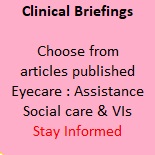Ophthalmology and OMPs
Semaglutide and the Optic Nerve: possible safety alert?
Semaglutide and the Optic Nerve: possible safety alert?
A large multicenter study has identified a small but statistically significant association between semaglutide and nonarteritic anterior ischemic optic neuropathy (NAION), a rare condition that can cause sudden vision loss.
The findings, published in JAMA Ophthalmology, represent the most comprehensive analysis to date on the potential link between this glucagon-like peptide-1 receptor agonist (GLP-1RA) and NAION in individuals with type 2 diabetes.
NAION is the leading cause of acute optic nerve damage in older adults, often related to impaired blood flow. While vascular conditions like diabetes and hypertension are known risk factors, the rapid growth in semaglutide prescriptions—used to manage both type 2 diabetes and obesity—has prompted researchers to explore whether the drug may contribute to this vision-threatening condition.
To investigate this possibility, researchers analyzed data from more than 37 million patients across 14 databases within the Observational Health Data Sciences and Informatics (OHDSI) network. They employed both an active-comparator new-user cohort design and a self-controlled case-series model to examine the incidence of NAION among users of semaglutide compared to other GLP-1RAs (dulaglutide, exenatide) and non–GLP-1RA diabetes medications (empagliflozin, sitagliptin, glipizide).
Among over 810,000 new users of semaglutide, NAION incidence was estimated at 14.5 per 100,000 person-years using a broader case definition, and 8.7 per 100,000 with a stricter, more specific one. While these figures are consistent with background rates in older adults, further analysis revealed a nuanced picture.
When applying the broader NAION definition, semaglutide was not associated with a significantly higher risk compared to other medications. However, under the specific definition, semaglutide was linked to an increased risk of NAION compared with empagliflozin (hazard ratio [HR] 2.27, 95% CI 1.16–4.46, P = .02). This association was further supported by a self-controlled case-series analysis, which found that individuals had a higher incidence of NAION during semaglutide exposure periods compared to non-exposure (incidence rate ratio [IRR] 1.32, 95% CI 1.14–1.54, P < .001).
These results offer a counterpoint to a previous single-center study published in 2024 that suggested a more than fourfold increase in NAION risk with semaglutide. The current study’s broader scope and diverse data sources suggest a more modest signal, though the authors emphasize that more research is needed.
Importantly, this increased risk did not appear across all drugs in the GLP-1RA class. Dulaglutide showed no significant association with NAION, and exenatide was linked to increased risk only when the specific definition was used. No elevated risk was observed with sitagliptin, glipizide, or empagliflozin under the broader criteria.
The mechanisms underlying a possible link between semaglutide and NAION remain speculative. While GLP-1RAs are generally thought to offer neuroprotective and cardiovascular benefits, it is possible that they may influence optic nerve perfusion through blood pressure regulation or autonomic effects. However, the study did not include detailed ophthalmic data such as optic disc anatomy, a key clinical predictor of NAION.
The authors caution that the findings should not be interpreted as proof of causation. Potential confounders—such as indication bias, limitations in diagnosis coding, and absence of imaging data—could influence the observed associations. For example, crowded optic nerves, a known risk factor for NAION, could not be assessed in this analysis.
Despite these limitations, the study’s scale and methodological rigor provide meaningful evidence that may inform clinical decisions. Whether these findings should influence prescribing practices, particularly for patients with known risk factors for NAION, remains an open question. The authors call for future studies that integrate detailed ophthalmologic and dosing information to further clarify the relationship.
For now, while the absolute risk appears low, clinicians are encouraged to remain aware of early visual symptoms in patients receiving semaglutide. The therapeutic benefits of the drug remain substantial, but continued monitoring is warranted as its use expands across broader populations.
Source
Cai, Cindy X., Michelle Hribar, Sally Baxter, Kerry Goetz, Swarup S. Swaminathan, Alexis Flowers, Eric N. Brown, et al. “Semaglutide and Nonarteritic Anterior Ischemic Optic Neuropathy.” JAMA Ophthalmology, published online February 20, 2025. https://doi.org/10.1001/jamaophthalmol.2024.6555.
























